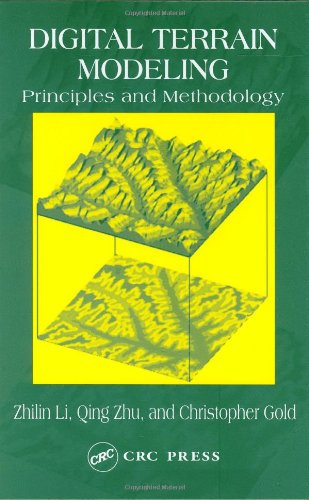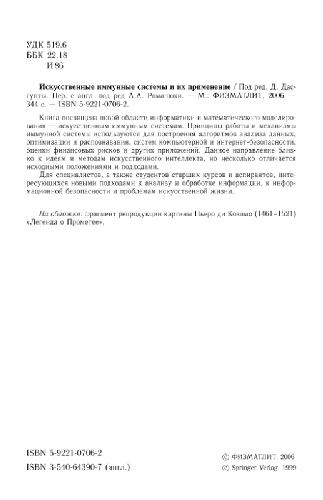Zhilin Li, Qing Zhu, Chris Gold9780415324625, 0415324629
Table of contents :
Digital Terrain Modeling: Principles and Methodology……Page 1
Preface……Page 12
Contents……Page 3
1.1.1 Representation of Terrain Surfaces……Page 14
1.2.1 The Concept of Model and Mathematical Models……Page 17
1.2.2 The Terrain Model and the Digital Terrain Model……Page 19
1.2.3 Digital Elevation Models and Digital Terrain Models……Page 20
1.3.2 Development of Digital Terrain Modeling……Page 22
1.4 RELATIONSHIPS BETWEEN DIGITAL TERRAIN MODELING AND OTHER DISCIPLINES……Page 24
2.1 GENERAL (QUALITATIVE) TERRAIN DESCRIPTORS……Page 26
2.2.1 Frequency Spectrum……Page 27
2.2.2 Fractal Dimension……Page 28
2.2.3 Curvature……Page 29
2.2.5 Semivariogram……Page 30
2.3.1 Slope, Relief, and Wavelength as a Roughness Vector……Page 31
2.3.2 The Adequacy of the Terrain Roughness Vector for DTM Purposes……Page 32
2.3.3 Estimation of Slope……Page 33
2.4.1 Theoretical Background for Sampling……Page 34
2.4.2 Sampling from Different Points of View……Page 35
2.5.1 Selective Sampling: Very Important Points plus Other Points……Page 37
2.5.3 Sampling with Two Dimensions Fixed: Regular Grid and Progressive Sampling……Page 38
2.6.1 Distribution of Sampled Source Data……Page 39
2.6.3 Accuracy of Sampled Source Data……Page 41
3.1.1 The Terrain Surface as a Data Source……Page 43
3.1.2 Aerial and Space Images……Page 44
3.1.3 Existing Topographic Maps……Page 46
3.2.1 The Development of Photogrammetry……Page 47
3.2.2 Basic Principles of Photogrammetry……Page 48
3.3 RADARGRAMMETRY AND SAR INTERFEROMETRY……Page 51
3.3.1 The Principle of Synthetic Aperture Radar Imaging……Page 52
3.3.2 Principles of Interferometric SAR……Page 55
3.3.3 Principles of Radargrammetry……Page 60
3.4 AIRBORNE LASER SCANNING (LIDAR)……Page 62
3.4.1.1 Range and Range Resolution……Page 65
3.4.1.2 Maximum Unambiguous Range……Page 66
3.4.2 From Laser Point Cloud to DTM……Page 67
3.5.1 Line-Following Digitization……Page 68
3.5.2 Raster Scanning……Page 69
3.6.1 The Operation of GPS……Page 70
3.6.2 The Principles of GPS Measurement……Page 72
3.6.3 The Principles of Traditional Surveying Techniques……Page 73
3.7 A COMPARISON BETWEEN DTM DATA FROM DIFFERENT SOURCES……Page 74
4.1.1 Interpolation and Surface Modeling……Page 76
4.1.3 Surface Modeling Function: General Polynomial……Page 77
4.2 APPROACHES FOR DIGITAL TERRAIN SURFACE MODELING……Page 78
4.2.2 Point-Based Surface Modeling……Page 79
4.2.3 Triangle-Based Surface Modeling……Page 80
4.2.4 Grid-Based Surface Modeling……Page 81
4.2.5 Hybrid Surface Modeling……Page 82
4.3.2 Discontinuous DTM Surfaces……Page 83
4.3.3 Continuous DTM Surfaces……Page 84
4.3.4 Smooth DTM Surfaces……Page 85
4.4.1 Triangular Regular Network Formation from Regularly Distributed Data……Page 86
4.4.2 Triangular Irregular Network Formation from Regularly Distributed Data……Page 88
4.4.3 Triangular Irregular Network Formation from Irregularly Distributed Data……Page 90
4.5 GRID NETWORK FORMATION FOR SURFACE MODELING……Page 91
4.5.1 Coarser Grid Network Formation from Finer Grid Data: Resampling……Page 92
4.5.2 Grid Network Formation from Randomly Distributed Data……Page 93
4.5.3 Grid Network Formation from Contour Data……Page 94
5.1.1 Approaches for Triangular Irregular Network Formation……Page 97
5.1.2 Principles of Triangular Irregular Network Formation……Page 98
5.2.1 Selection of a Starting Point for Delaunay Triangulation……Page 100
5.2.2 Searching for a Point to Form a New Triangle……Page 102
5.2.3 The Process of Delaunay Triangulation……Page 103
5.3.1 The Principle of Bowyer–Watson Algorithm for Dynamic Triangulation……Page 104
5.3.2 Walk-Through Algorithm for Locating the Triangle Containing a Point……Page 105
5.3.3 Numerical Criterion for Edge Swapping……Page 107
5.3.4 Removal of a Point from the Delaunay Triangulation……Page 108
5.4.1 Constraints for Delaunay Triangulation: The Issue and Solutions……Page 109
5.4.2 Delaunay Triangulation with Constraints……Page 111
5.5 TRIANGULATION FROM CONTOUR DATA WITH SKELETONIZATION……Page 112
5.5.1 Extraction of Skeleton Lines from Contour Map……Page 113
5.5.2 Height Estimation for Skeleton Points……Page 114
5.5.3 Triangulation from Contour Data with Skeletons……Page 116
5.6 DELAUNAY TRIANGULATIONS VIA VORONOI DIAGRAMS……Page 117
5.6.2 Vector-Based Algorithms for the Generation of Voronoi Diagram……Page 118
5.6.3 Raster-Based Algorithms for the Generation of Voronoi Diagram……Page 121
6.1 INTERPOLATION TECHNIQUES: AN OVERVIEW……Page 125
6.2.2 Bilinear Interpolation……Page 127
6.3.1 Bicubic Spline Interpolation……Page 129
6.3.2 Multi-Surface Interpolation (Hardy Method)……Page 130
6.4.1 Least-Squares Fitting of a Local Surface……Page 133
6.4.2 Least-Squares Fitting of Finite Elements……Page 136
6.5.1 The Principle of Point-Based Moving Averaging……Page 137
6.5.2 Searching for Neighbor Points……Page 138
6.5.3 Determination of Weighting Functions……Page 139
6.6 POINT-BASED MOVING SURFACES……Page 140
6.6.2 Selection of Points……Page 141
7.1.1 A Simple Strategy for Quality Control in Digital Terrain Modeling……Page 143
7.1.3 Types of Error in DTM Source Data……Page 144
7.2.2 Zero Stereo Model from Orthoimages……Page 145
7.3 FILTERING OF THE RANDOM ERRORS OF THE ORIGINAL DATA……Page 146
7.3.1 The Effect of Random Noise on the Quality of DTM Data……Page 147
7.3.2 Low-Pass Filter for Noise Filtering……Page 149
7.3.3 Improvement of DTM Data Quality by Filtering……Page 150
7.3.4 Discussion: When to Apply a Low-Pass Filtering……Page 151
7.4 DETECTION OF GROSS ERRORS IN GRID DATA BASED ON SLOPE INFORMATION……Page 152
7.4.2 General Principle of Gross Error Detection Based on an Adaptive Threshold……Page 153
7.4.3 Computation of an Adaptive Threshold……Page 155
7.4.4 Detection of Gross Error and Correction of a Point……Page 156
7.5 DETECTION OF ISOLATED GROSS ERRORS IN IRREGULARLY DISTRIBUTED DATA……Page 157
7.5.1 Three Approaches for Developing Algorithms for Gross Error Detection……Page 158
7.5.3 Range of Neighbors (Size of Window)……Page 159
7.5.5 A Practical Example……Page 160
7.6.1 Gross Errors in Cluster: The Issue……Page 161
7.6.2 The Algorithm for Detecting Gross Errors in Clusters……Page 163
7.6.3 A Practical Example……Page 164
7.7.1 Gross Errors in Contour Data: An Example……Page 165
7.7.2 Topological Relations of Contours for Gross Error Detection……Page 166
8.1.1 Approaches for DTM Accuracy Assessment……Page 168
8.1.2 Distributions of DTM Errors……Page 169
8.1.3 Measures for DTM Accuracy……Page 170
8.1.4 Factors Affecting DTM Accuracy……Page 172
8.2.1 Strategies for Experimental Tests……Page 174
8.2.2 Requirements for Checkpoints in Experimental Tests*……Page 175
8.3.2 Empirical Models for the Relationship between DTM Accuracy and Sampling Intervals……Page 179
8.3.3 Empirical Models for DTM Accuracy Improvement with the Addition of Feature Data……Page 181
8.4 THEORETICAL MODELS OF DTM ACCURACY BASED ON SLOPE AND SAMPLING INTERVAL*……Page 182
8.4.1 Theoretical Models for DTM Accuracy: An Overview……Page 183
8.4.2 Propagation of Errors from DTM Source Data to the DTM Surface……Page 187
8.4.3 Accuracy Loss Due to Linear Representation of Terrain Surface……Page 189
8.4.3.2 Extreme Error ( Emax) Due to Linear Representation……Page 190
8.4.3.3 A Practical Consideration Regarding Emax and……Page 193
8.4.4 Mathematical Models of the Accuracy of DTMs Linearly Constructed from Grid Data……Page 195
8.5.1 Empirical Model for the Accuracy of DTMs Constructed from Contour Data……Page 197
8.5.2 Empirical Model for the Relationship between Contour and Grid Intervals……Page 198
9.1.1 Scale as an Important Issue in Digital Terrain Modeling……Page 200
9.1.2 Transformation in Scale: An Irreversible Process in Geographical Space……Page 201
9.1.3 Scale, Resolution and Simplification of Representations……Page 203
9.1.4 Approaches for Multi-Scale Representations……Page 204
9.2.1 Pyramidal Structure for Hierarchical Representation……Page 205
9.2.2 Quadtree Structure for Hierarchical Representation……Page 207
9.3.2 A Natural Principle for DTM Generalization……Page 209
9.3.3 DTM Generalization Based on the Natural Principle……Page 211
9.4.1 Principles for View-Dependent LOD……Page 214
9.4.2 Typical Algorithms for View-Dependent LOD for DTM Data……Page 216
9.5 MULTI-SCALE DTM AT A NATIONAL LEVEL……Page 217
9.5.2 Multi-Scale DTM in the United States……Page 218
10.1.1 Strategy for Making DTM Data Management Operational……Page 219
10.1.2 Strategy for Using Databases for DTM Data Management……Page 220
10.2.1 File Structure for Grid DTM……Page 221
10.2.2 File Structure for TIN DTM……Page 222
10.2.3 File Structure for Additional Terrain Feature Data……Page 224
10.3 MANAGEMENT OF DTM DATA WITH SPATIAL DATABASES……Page 225
10.3.1 Organization of Tables for Grid DTM Data……Page 226
10.3.2 Organization of Tables for TIN DTM Data……Page 229
10.3.3 Organization of Tables for Additional Terrain Feature Data……Page 231
10.3.4 Organization of Tables for Metadata……Page 233
10.4.1 Concepts and Approaches for DTM Data Compression……Page 234
10.4.2 Huffman Coding……Page 235
10.4.3 Differencing Followed by Coding……Page 236
10.5 STANDARDS FOR DTM DATA FORMAT……Page 237
10.5.1 Concepts and Principles of DTM Data Standards……Page 238
10.5.3 Standards for DTM Data Exchange of China……Page 239
11.2 VECTOR-BASED CONTOURING FROM GRID DTM……Page 240
11.2.1 Searching for Contour Points……Page 241
11.2.2 Interpolation of Contour Points……Page 242
11.2.3 Tracing Contour Lines……Page 243
11.3 RASTER-BASED CONTOURING FROM GRID DTM……Page 245
11.3.1 Binary and Edge Contouring……Page 246
11.4 VECTOR-BASED CONTOURING FROM TRIANGULATED DTM……Page 248
11.5.1 The Principle of Stereo Contouring……Page 250
11.5.2 Generation of Stereomate for Contour Map……Page 252
12.1.1 Variables for Visualization……Page 254
12.2 IMAGE-BASED 2-D DTM VISUALIZATION……Page 257
12.2.1 Slope Shading and Hill Shading……Page 258
12.2.2 Height-Based Coloring……Page 259
12.3.1 Basic Principles of Rendering……Page 260
12.3.2 Graphic Transformations……Page 261
12.3.3 Visible Surfaces Identification……Page 263
12.3.4 The Selection of an Illumination Model……Page 264
12.3.5 Gray Value Assignment for Graphics Generation……Page 266
12.4.1 Mapping Texture onto DTM Surfaces……Page 267
12.5 ANIMATION TECHNIQUES FOR DTM VISUALIZATION……Page 269
12.5.1 Principles of Animation……Page 270
12.5.2 Seamless Pan-View on DTM in a Large Area……Page 271
12.5.3 “Fly-Through” and ÏWalk-ThroughÓ for DTM Visualization……Page 273
13.2 GEOMETRIC TERRAIN PARAMETERS……Page 274
13.2.1 Surface and Projection Areas……Page 275
13.2.2 Volume……Page 277
13.3.1 Slope and Aspect……Page 278
13.3.2 Plan and Profile Curvatures……Page 281
13.3.4 Roughness Parameters……Page 282
13.4.1 Flow Direction……Page 283
13.4.2 Flow Accumulation and Flow Line……Page 285
13.4.3 Drainage Network and Catchments……Page 286
13.4.4 Multiple Direction Flow Modeling: A Discussion……Page 287
13.5 VISIBILITY TERRAIN PARAMETERS……Page 288
13.5.1 Line-of-Sight: Point-to-Point Visibility……Page 289
13.5.2 Viewshed: Point-to-Area Visibility……Page 290
14.1.1 Highway and Railway Design……Page 292
14.1.2 Water Conservancy……Page 293
14.2.1 Orthoimage Generation……Page 295
14.3.1 Flight Simulation……Page 297
14.4.1 Wind Field Models for Environmental Study……Page 298
14.4.3 Flood Simulation……Page 299
14.5 MARINE NAVIGATION……Page 300
14.6 OTHER APPLICATIONS……Page 302
15.1.1 Manual Addition of Constructions on Terrain Surface……Page 303
15.1.2 Semiautomated Modification of the Terrain Surface……Page 304
15.2.1 Generation of TIN and Voronoi Diagram on Sphere……Page 306
15.2.2 Voronoi Diagram for Modeling Changes in Sea Level on Sphere……Page 307
15.3 THREE-DIMENSIONAL VOLUMETRIC MODELING……Page 308
Epilogue……Page 311
References……Page 313







Reviews
There are no reviews yet.